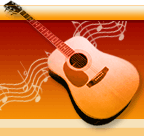Reading Guitar Tabs for Beginners
Reading guitar tabs is essential for any guitarist whether they play an electric or acoustic guitar. As most guitar players are self-taught, they haven't studied music theory and can't often "sight read" music. Guitar tabs are just a slightly simpler form of notating music than traditional music notation and although, at first, they may look complex are easy to grasp.
A tab is basically a musical staff made up of six horizontal lines. Each one, instead of representing a musical note as in traditional musical notation, represents a guitar string. The lowest line represents the lowest string E, the second the A string and so on.
On the tab there will be numbers on each line or guitar string, this represents not which finger to play with but on which fret to play the note. If there is a 0 on the tab, this means play an open string at that point. Which finger you use for which note you can decide for yourself and, as you get more used to playing, will become self-evident.
You can read chords with guitar tabs. A series of vertical numbers on the tab indicate playing all the notes at the same time, most tabs include the chord name too to help guitarists recognize the chord. If the chord is slanted across the tab, this usually means playing the notes in the chord one at a time rather than altogether, though the tab won't usually tell you how fast or how slow to play them.
The letter h represents a hammer-on. So if you were to see the instruction 8h6, you would hold down the 8th fret, pluck the string and then hammer-on to the 6th. Sometimes the h is represented by a ^ symbol or, on more formal guitar tabs, as a curved line. The letter p represents, like the hammer-on, the pull-off so that 8p6 represents fretting and picking the 8th fret and then, without re-plucking the string, moving on the 6th fret. Again the pull-off can be represented by a ^ or a curved line.
Symbol / denotes an ascending slide and \ a descending slide, though slides are sometimes represented by an s. The number before or after the stroke denotes the fret to slide up to or down from. String bends can be shown by the use of a b, which is followed by the note that the original note should be bent to which is sometimes shown in brackets. Vibrato is often indicated by a squiggle, the size of the squiggle indicating the amount of vibrato needed. Vibrato can also be shown by a ~ or a v.
There are of course problems with guitar tabs, one of the major ones is that they don't express the rhythm of a tune in any way so that you really need to have heard how the guitar part of any song you want to play goes before trying to play it by tab. Tabs are also particularly aimed at guitarists and so are almost impossible for other musicians to read and understand. Dawsons Music has a range of guitar tab books while there are plenty of websites featuring tabs for popular songs on the internet.
A tab is basically a musical staff made up of six horizontal lines. Each one, instead of representing a musical note as in traditional musical notation, represents a guitar string. The lowest line represents the lowest string E, the second the A string and so on.
On the tab there will be numbers on each line or guitar string, this represents not which finger to play with but on which fret to play the note. If there is a 0 on the tab, this means play an open string at that point. Which finger you use for which note you can decide for yourself and, as you get more used to playing, will become self-evident.
You can read chords with guitar tabs. A series of vertical numbers on the tab indicate playing all the notes at the same time, most tabs include the chord name too to help guitarists recognize the chord. If the chord is slanted across the tab, this usually means playing the notes in the chord one at a time rather than altogether, though the tab won't usually tell you how fast or how slow to play them.
The letter h represents a hammer-on. So if you were to see the instruction 8h6, you would hold down the 8th fret, pluck the string and then hammer-on to the 6th. Sometimes the h is represented by a ^ symbol or, on more formal guitar tabs, as a curved line. The letter p represents, like the hammer-on, the pull-off so that 8p6 represents fretting and picking the 8th fret and then, without re-plucking the string, moving on the 6th fret. Again the pull-off can be represented by a ^ or a curved line.
Symbol / denotes an ascending slide and \ a descending slide, though slides are sometimes represented by an s. The number before or after the stroke denotes the fret to slide up to or down from. String bends can be shown by the use of a b, which is followed by the note that the original note should be bent to which is sometimes shown in brackets. Vibrato is often indicated by a squiggle, the size of the squiggle indicating the amount of vibrato needed. Vibrato can also be shown by a ~ or a v.
There are of course problems with guitar tabs, one of the major ones is that they don't express the rhythm of a tune in any way so that you really need to have heard how the guitar part of any song you want to play goes before trying to play it by tab. Tabs are also particularly aimed at guitarists and so are almost impossible for other musicians to read and understand. Dawsons Music has a range of guitar tab books while there are plenty of websites featuring tabs for popular songs on the internet.
Recent Articles
- How to Take Care of Your Guitar
Any musical instrument requires careful maintenance and guitar is no different. Learn how to take care of your guitar so that it stays looking and sounding good throughout the time that you own and play it... Read the full article »
- Learning Acoustic Guitar For Beginners
Everyone listens to music, so why not taking on the challenge to become a musician yourself? Here are some tips to help you on your way to learning to play an acoustic guitar... Read the full article »
- Guitar Apprentice – You Will Love This
Guitar Apprentice is a revolutionary video training system that takes learning guitar to the next level. It's like Guitar Hero, but with a real guitar... Read the full article »
- Good Guitar Lessons For Beginners
You can't learn guitar without good lessons. And you have to understand that it's not going to be easy. Avoid frustration and discouragement and find out where to look for good lessons... Read the full article »
- What Is The Best Way To Learn Guitar?
What do you need in order to really learn guitar? Three things - good instructions, commitment and the right attitude. There is certainly a right way and a wrong way to go about it. Discover the best way to learn guitar... Read the full article »


